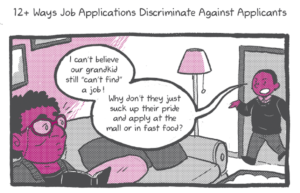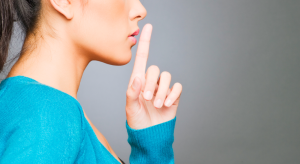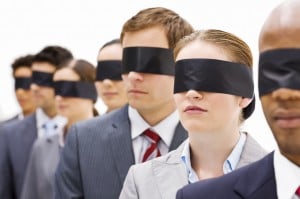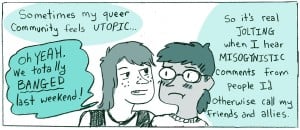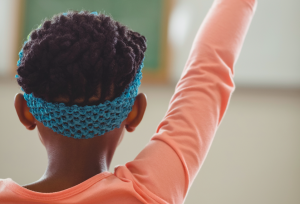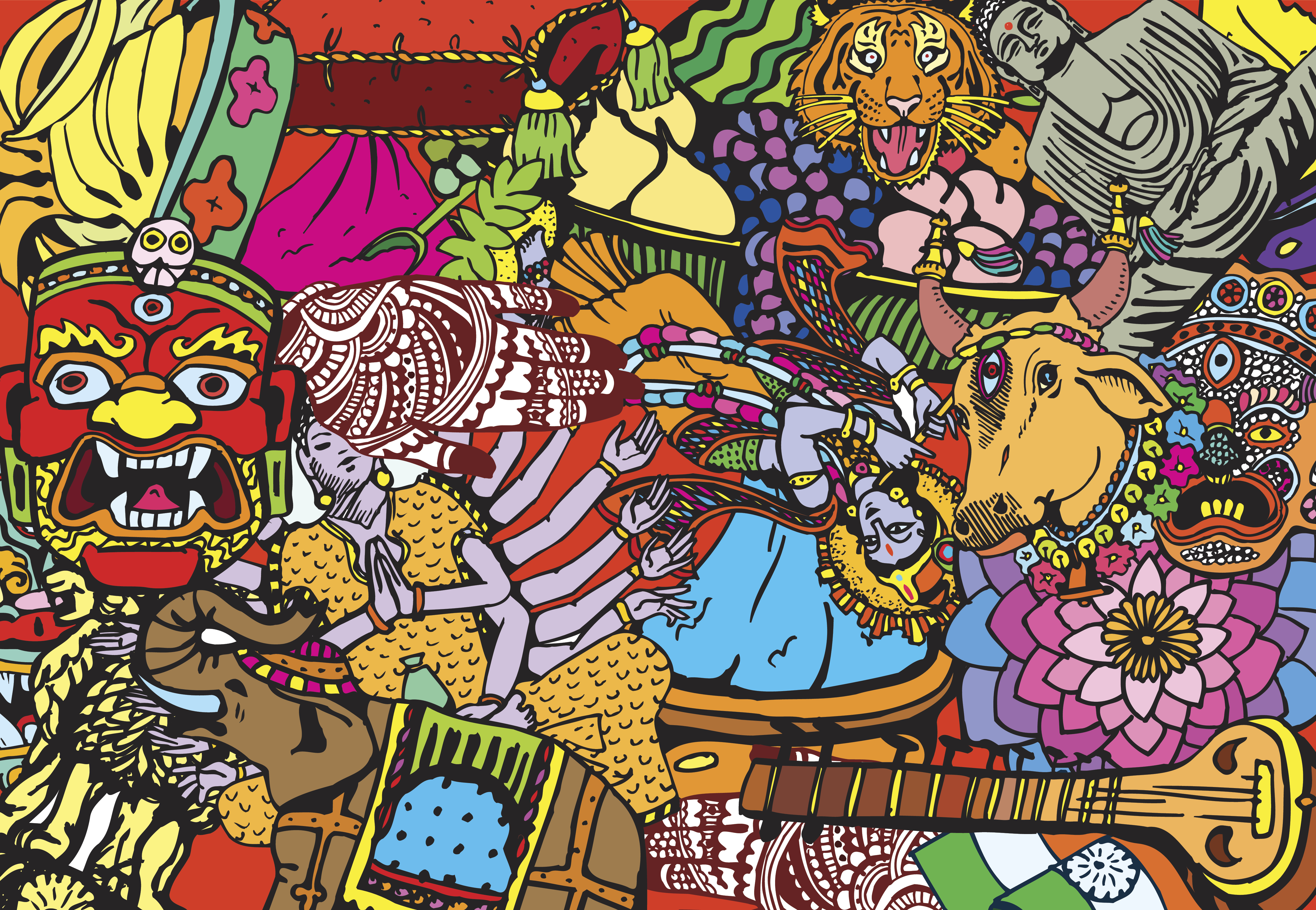
Colorful illustration of South Asian themes.
As a U.S. born South Asian, I have found a lot of power in reclaiming the bindi. Especially because, to me, it isn’t just a decorative symbol.
When I wear a bindi, it represents my resistance to the ways that my South Asian community has policed my gender and claimed that South Asianness is narrow in its possibilities.
As people of various diasporas — that is, people who have migrated from their homeland(s) for whatever reason — we often struggle with feeling like we don’t belong.
Often, we live between multiple cultures and might face all sorts of reductive stereotypes. Mainstream narratives in the U.S. often undermine the emotional consequences of things like microaggressions and cultural identity conflicts, but these problems are definitely significant.
It’s important to work through these struggles by doing things like reclaiming our culture — proving to ourselves and the world that we’re not simple stereotypes, we’re way more complex and beautiful.
But this can get tricky. Sometimes, reclaiming culture can also mean self-stereotyping. And doing so can further perpetuate limited and harmful conceptions of who we are.
There are two main reasons why we might be considered to be culturally appropriating as people of the Asian diaspora. The first is we’re reclaiming our culture with some unfamiliarity and distance from the cultures of our “homelands.”
The second reason is we’re working the system to gain some financial advantages from selling or displaying cultural stereotypes.
I want to talk about these two reasons for self-stereotyping, and then consider whether it’s okay for us to do it when, as I mentioned, it can reproduce reductive stereotypes.
First, I’ll give you a little historical background for all of this.
White Americans primarily constructed ‘Oriental’ stereotypes, often in accordance with the United States’ diplomatic relationships with Asian countries.
But after World War II and during the rise of U.S. imperialism, lots of Asians in the U.S. started to self-stereotype and assimilate in order to gain financial mobility and cultural acceptance.
So, in a sense, they played a role in constructing their own stereotypes, but they did so to survive as marginalized immigrants.
Diasporic Asians in the U.S. self-stereotyped to prove themselves worthy of citizenship — to prove that they weren’t bad immigrants but good respectable ones that modeled white, middle-class American values, according to author Ellen D. Wu.
I want to talk about how this conversation about diasporic Asians self-stereotyping continues to this day.
So, let’s get into the two main ways that diasporic Asians are said to self-stereotype:
1. Asians of the diaspora can reclaim our cultures ‘at a distance’
In an article for Black Girl Dangerous, South Asian artist and activist Janani claims that South Asians have “a lot more than Bollywood and chai and henna going for us,” so diasporic South Asians need to “quit Orientalizing our cultures.”
They speak about how our distance from South Asia (“in geography, class, Western socialization”) can produce an unfamiliarity of lived experience and culture of native people in South Asia.
Basically, they’re making the really valid assertion that we need to be critical about our positions as diasporic (South) Asian people. Particularly with lived experience, we can’t claim to understand what everyone in South Asia goes through.
So, making assumptions and spreading that along to all of our white friends would be pretty misguided. But, similarly, we can’t assume what other South Asians in the United States go through.
Wrapped up in their message is also their assertion that (South) Asians of the diaspora always have an “incomplete and secondhand” knowledge of (South) Asian culture.
To me, this is a pretty problematic claim.
Diasporic Asians definitely don’t have less of an understanding of Asian culture than do native Asians.
This belief is rooted in the oppressive idea that culture is pure and uniform.
It’s also rooted in the destructive concept that people who have “mixed ancestry” are impure — that they have a distance from “pure” culture, and so they will never be complete.
No culture is the culture, and I think an important aspect of diasporic culture is negotiating the explicit or implicit messages we receive telling us we’re not fully complete.
Nonetheless, sometimes diasporic people (whether for social capital or simply based on our understandings of Asian culture) can reproduce stereotypes when stereotypes are the limits of our exposure to Asian culture.
But I don’t think it isn’t as simple as telling Asians of the diaspora that we need to quit irresponsibly reclaiming our cultures.
It’s more a matter of deciding how we can heal while we’re existing in a white supremacist world that has constructed racist and reductive stereotypes in the first place, and checking ourselves on how we’re profiting from reproducing these stereotypes (and at whose expense).
2. Asians of the diaspora selling our stereotypes for financial profit
Early 20th-century U.S.-born Chinese actress Anna May Wong was often cast in roles that exoticized and sexualized her as a stereotypical ‘Oriental’ woman.
Wong’s portrayal of these Orientalized roles widely influenced the image of Chinese American femaleness in the mainstream. Her roles perpetuated stereotypes in addition to narrow standards for the appearance and performance of Asian femininities.
While it isn’t her fault that white Americans were racist as hell, she did play a role in accepting these roles rather than challenging them. It’s likely also that her accepting these roles can be explained by the fact that her ideas about China were constructed in part by U.S. media representation.
But she accepted the roles she did mostly because she was working with what she was given. She wanted to pursue a film acting career, so she did whatever that took.
Many Bengali men also did this sort of thing in the United States in the late 1800s.
They knew that (mostly) white Americans held all these Oriental ideas about South Asian culture, and so they used that to their advantage to sell silk (much of which their wives made back home in Bengal) in New Jersey, New Orleans, and elsewhere around the U.S.
They would make this money in the U.S. and then send it back to their families in South Asia.
Both of these types of self-stereotyping directly financially benefited the people who participated. So, they were working the system to get something out of it.
***
To what extent is this self-stereotyping problematic?
In my experience, Asians of the diaspora in the U.S. will stereotype themselves because it affords them something — like, social likeability, money, resources, or sexual and romantic desirability.
As I mentioned, this situation exists because of white supremacy.
When people experience structural oppression on any level — financial, cultural, emotional, etc. — it’s not fair to tell them to not cope with that in whatever ways they are able.
We can’t go around telling (especially more marginalized) members of our diasporic Asian communities that we’re further restricting their cultural expression when there are already many limits to the extent to which diasporic (and dysphoric) people can achieve cultural belonging.
But the matter of whether self-stereotyping is problematic also depends on how Asian diasporic people are benefitting from their self-stereotyping. If it’s for the sake of survival, great.
Asians of the diaspora, though, experience varying degrees of privilege depending on their geographic locations and their intersecting identities. This means that some Asians very well could be riding the wave of U.S. anti-Blackness and imperialism to get ahead while exploiting others.
So, then, there really is no easy answer as to whether or not it’s cool for all diasporic Asians to stereotype ourselves.
But, what’s more certain is that we as diasporic Asians need to challenge the white gaze while claiming our right to reclaim our cultures as diasporic people.
To do this, we can consider why we want to embrace parts of our culture. Is it because it feels good to accept parts of ourselves after previously rejecting them?
Or, is it because we’re trying to appeal to white people when we really should be pushing ourselves to find cultural affirmation outside of restrictive stereotypes?
It’s important to ask ourselves these questions as we challenge the basic ways that we’ve learned to think about what it means to be diasporic and Asian.
[do_widget id=’text-101′]
Ayesha Sharma is a non-binary South Asian scholar and artist continually negotiating a relationship with themselves and their communities through practices of decolonization. They are most interested in literal and symbolic reclamation as an art practice and investing themselves in community care. Ayesha has written for the Urban Democracy Lab and is published in ANTYAJAA: Indian Journal of Women and Social Change.
Search our 3000+ articles!
Read our articles about:
Our online racial justice training
Used by hundreds of universities, non-profits, and businesses.
Click to learn more








